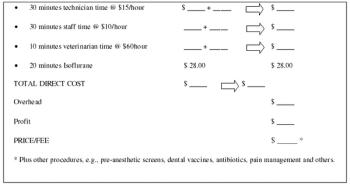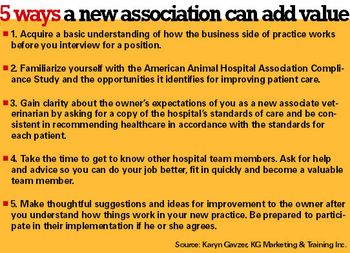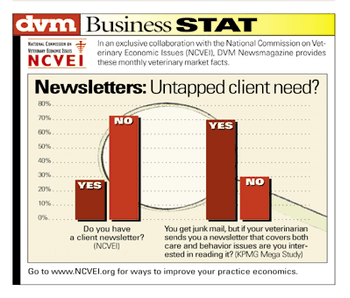
Deciding how to price and what fees to set are some of the most fundamental, yet intimidating marketing decisions veterinarians and practice managers face.

Karyn Gavzer, MBA, CVPM, is a veterinary business consultant and widely known writer and speaker. She says her job is to help practices "go and grow" with training, marketing and new ideas. Gavzer has decades of experience in the veterinary industry. She helped create public education campaigns to improve pet health care and encourage owners to take their pets to their veterinarians more often. Gavzer works with practices, associations and industry.

Deciding how to price and what fees to set are some of the most fundamental, yet intimidating marketing decisions veterinarians and practice managers face.

What is the best way to tell your clients about the new things you do? Which marketing activities are the most effective for your practice? What should you change or stop doing?

Simple but important tips for a more rewarding and enjoyable first year on the job.

Cats are the most popular modern pet, according to the American Veterinary Medical Association's (AVMA) latest "U.S. Pet Ownership and Demographic Sourcebook." But even though they outnumber dogs in homes, it's a different story when it comes to veterinary care.

Whether you are about to graduate and join a practice as a new associate or if you are still in school, it is important to understand the new findings concerning the role emotions play in building healthy, successful client relationships.

Most veterinary medical graduates care more about the chance to diagnose and treat patients than the size of their paycheck. Still, salaries matter, especially when today's former students are saddled with an educational debt load of $100,000 or more.

When it comes to a veterinary student's first job, anxiety comes standard. Speculation about life following graduation is also a given.

Standards of care set the stage for you and your clients so you can work together to help pets stay sleek, strong, and full of energy.

The biggest share of practice advertising dollars is spent on Yellow Pages ads. The following are practical guidelines to help you think through your Yellow Pages strategy, improve your ad's efficacy and reduce costs.

The practice owner was impressed Keri put so much thought and effort into her job.

This simple marketing tool can be used to help you see opportunities and challenges that can help or hurt your practice's growth.

Reminder cards are veterinarians' strongest tool to build repeat business and help their clients keep up-to-date on their pets' care.

Your job as a leader is to make sure that the team has challenging tasks to keep them engaged.

The leader's role changes at each stage of team development. Are you doing the right things to help your team grow and go?

In a world of look alikes, what is your practice's competitive advantage? In my experience, if you ask practice owners, managers or employees that question, then most will say that they are a "high-quality" or a "full-service" practice. Who isn't? Furthermore, if your answer is no different from anyone else's, then aren't you really saying that you are much the same as everyone else?

Almost all tips for interviewing are written to help the person being interviewed do well. What if you're the boss and the one conducting the interview?

No other single marketing decision impacts your bottom line as directly and powerfully as pricing: A 5 percent price increase is a 5 percent increase to your bottom line.

Client surveys are limited to the extent that they only provide information on past performance.

Today it takes a winning team to run a successful practice.

If you are like most practice owners and managers, you probably spend most of your time on "people problems."

No other single marketing decision impacts your bottom line as directly and powerfully as pricing.

There's never time to train in most veterinary practices. All too often, much of a new employee's training ends up being by "osmosis," or the "hang-around-you'll-get-it" method. Training doesn't have to be so hit or miss.

Ms. Karyn Gavzer identifies the barriers that prevent the veterinary team from getting clients to act on prescribed medical services.